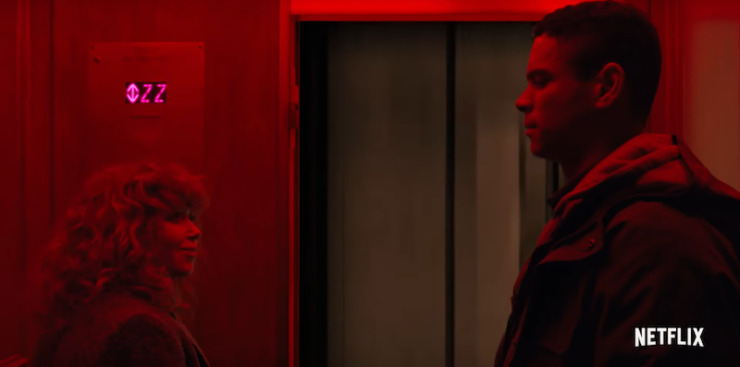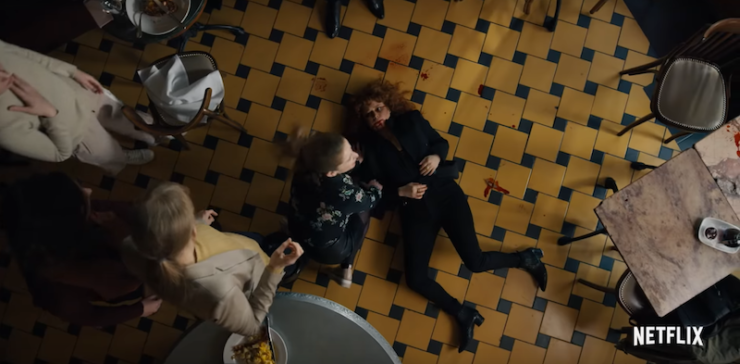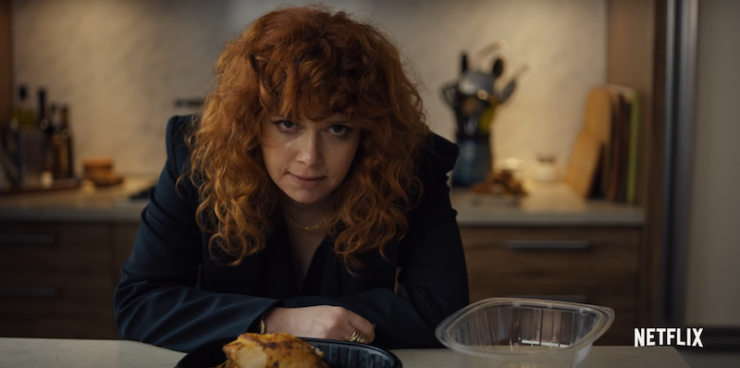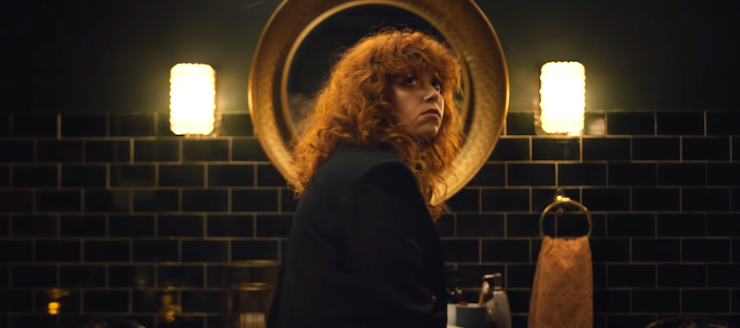Our cultural approach to the subject of mental health has gotten somewhat healthier over the years. Where discussions of depression, anxiety, therapy, and medication used to be taboo, we are now encouraged (in some spheres, at least) to speak more openly, to connect and reassure each other that no one is alone in these struggles. Celebrities are praised for speaking about mental health in award acceptance speeches; some companies offer mental health days in addition to their sick day policies; scientists are learning that most human beings go through dips and valleys in their mental well being at some point in their lives. As this becomes more common and accepted, it only stands to reason that our stories should reflect this seismic shift—and new Netflix standout Russian Doll aspires to do just that with startling clarity.
[Spoilers for Russian Doll season one.]
Russian Doll follows Nadia Vulvokov as she finds herself stuck in a time loop that begins in the bathroom at her 36th birthday party and resets whenever she suddenly dies: whether getting hit by a cab, falling down tricky apartment stairs, tripping into an open cellar door—you know, all the ways New York City is perfectly poised to do you in. As Nadia makes her way through these constant and traumatizing reboots, she eventually finds another person who is stuck in the same loop—a man named Alan Zevani. Unlike Nadia, Alan initially believed that these loops were a chance to relive a single moment until he got it right (a failed marriage proposal to his girlfriend Beatrice, who is having an affair with another man), but later decided that the loops were punishment on them both for being bad people.
The truth is, neither Nadia nor Alan are truly “bad” people at the core. But they are both caught up in their unresolved pasts and pain so much that they actively hurt the people around them. On Nadia’s end, these issues are rooted in childhood trauma—her own mother was mentally ill and so behaviorally erratic that Nadia had to be taken from her and placed into the custody of Ruth Brenner, a family friend and therapist. For Alan, the fear of his own undiagnosed mental illnesses (he shows clear inclination toward severe depression and obsessive-compulsive behaviors) means that he has been treading water, poorly, for ages in an effort to prove everything is fine. Pointedly, both Nadia and Alan are scared of being labeled “crazy,” which affects their feelings toward any manner of treatment or aid for the difficulties they face. They both shun and deride the mere idea of therapy; Alan has never attempted it despite how clearly he needs it, and Nadia foregoes the offers of help from Ruth, even though her guardian has been trying to advise Nadia on these problems since she was a teenager. Alan and Nadia share a fear of being vulnerable to anyone and everything, and have convinced themselves that their actions aren’t hurting anyone in their radius.

What both fail to come to terms with is the fact that their friends and family are fully aware that they are not fine—and are constantly picking up the pieces behind them. Nadia’s friends love her enough to suffer her sarcasm and sometimes downright meanness, but her fear of getting close to people and accepting change results in cruel reactions to simple discomforts, such as backing out on the day when she was supposed to meet her boyfriend John’s daughter (after being a cause of the man’s divorce in the first place). Alan thinks that he’s doing an expert job at hiding how he’s struggling, but the only reason Beatrice didn’t break up their relationship ages ago was because she was scared that Alan might hurt himself if she moved on from him. Alan’s mother clearly worries for him; his friend Faran knows he has to be available to Alan in case something goes wrong. Alan and Nadia are both determined that they can pretend their way into being functional people without working on their problems, and everyone they know is expected to indulge in that fantasy by never calling them out when their choices don’t bear out by the light of day.
This has been the way of dealing with these issues for ages, in fiction and in reality. Narratives romanticize the heroes who chase their sadness to the bottom of bottles, push their feelings away or cut them out, try to forget. You see it in every Old West saloon or family drama with that one impossible parent. You see it in stories about war and addiction and generational anguish. You see it all around us from people we know: My own mother once shared a meme on Facebook with a picture of a sneering Jack Nicholson that read “If you had a shitty childhood, you have until you’re thirty to complain about it. After that, just shut up and drink like the rest of us.” But the worst part of this prevailing attitude is the sheer number of people who really think that this system works, that any form of abuse, trauma, or illness can be shrugged off with a killer combination of booze, distractions, and the right attitude.
Russian Doll could have gone this route, too, and even sets itself up as though it might. As Nadia and Alan try to reason their way out of this never-ending ferris wheel ride of fatalities, they realize that they both made a mistake before their first deaths—they saw each other in distress at Faran’s deli, and they didn’t help one another. They decide that they need to go back, replicate the event as it happened, and try to set everything right by giving each other a hand. In that moment, it seems as though this is what the story has been aiming for, the idea that we must help one another in order to live worthwhile lives. It’s certainly a good message to land on, and one that “time loop” stories are particularly enamored of in general.
Instead, Alan has an epiphany. The time loop is degrading; Nadia is now seeing a childhood version of herself crop up mysteriously right before she dies; people are disappearing from existence; and, fearing that they might not make it through another round, Alan decides that he needs to make amends first. He goes to Beatrice and tells her that he’s sorry for acting as though he didn’t see her unhappiness. He apologizes for never searching out help or trying to get a handle on his problems, and realizes that despite the fact that Nadia is “the most selfish person [he’s] ever known,” their odd and sudden friendship has made him a better person. Alan releases Beatrice with love and takes responsibility for his lack of care toward himself.
Nadia, on the other hand, is displeased with Alan’s choice to waste what precious time they might have left, but she goes to see Ruth and finally has a real conversation with the woman about her own past. She admits that she’s always believed that she abandoned her mother—she remembers telling social services that she wanted to live with Ruth, and her mother died within a year. Ruth insists that she’s wrong about all of it, as Nadia told them she wanted to live with her mother, but Nadia insists that the outcome was the same. Ruth finally tells Nadia that it wasn’t wrong to want to get away from her mother:
“You wanted to live. It’s the most beautiful thing in the world… …Do you still have that in you? I look at you now, chasing down death at every corner, and Nadia, where is that gorgeous part of you pushing to be a part of this world?”
In that moment, a tearful Nadia has her own revelation and finally goes to meet John’s daughter at their rescheduled breakfast. During their meeting, Nadia begins dying again and pulls a glass shard from her own mouth, a fragment from all the mirrors her mother broke during one of her worst spells. The child version of Nadia appears over her body and asks a question: “Are you ready to let her die? This is the day we get free.” That phrase is layered with meaning, but the central truth of it isn’t so hard to suss out—Nadia has to let go of her mother in order to begin living for the first time. She’s been bogged down in symbols of the woman this whole time; the hair that her mother once called her “crowning glory”; the Krugerrand necklace that was meant to be an inheritance from her grandparents; her 36th birthday, which marks her living one year longer than her mother ever did. Nadia has been living solely to honor the memory of others without caring whether or not her life had any meaning for her. She is now being given permission by the little girl she was to free herself of that weight.

The loop kicks in again, but this time the cycle is repaired, all the missing people have returned, and she and Alan now have the opportunity to save each other. The chain of events is everything here—before they are permitted to fix their mistakes in regard to each other, they first have to acknowledge that they have neglected to work on themselves in any meaningful way. Nadia has hidden behind grief, blaming herself for her mother’s death, and shunning connections with others because she believes deep down that she is a terrible person who deserves to be alone. Alan has hidden in his routines and patterns, refusing to acknowledge that he hasn’t been a part of the world for many years, and that he needs help to keep going. This is the key that begins to break them out of the time loop. It isn’t only about caring for others, it’s about taking responsibility for your own development as a person.
Back in the restored time loop, Nadia walks out of the bathroom and into her birthday party, and for the very first time she takes stock of all the people there. She has kisses and hugs and words for everyone. Part of this might be relief at waking up from such an awful death, but she’s had plenty of other terrible experiences on this journey. The difference is that this time—and maybe for the first time—Nadia is taking joy in her life. She’s appreciating how loved she is, and how lucky to be surrounded by friends and art and drugs and food and the world’s strangeness. She needed to heal some old wounds before she could do that, and she could only do that by trying. And it’s by trying that she manages to save Alan, too, while he saves her in kind.
On the final round, Nadia and Alan find themselves having to aid one another in separate time loops, ones where they don’t know each other and somehow have to convince the other person to accept their help. The fact that they manage this comes down to the strong bond they’ve developed as they solved the time loop mystery together, and all the work they’ve done to grow over the course of this harrowing experience. Nadia has helped Alan become a more forceful and determined person through her own example—though the version of Nadia who doesn’t know Alan repeatedly refuses his offers of help, Alan doesn’t let that deter him from getting her attention and dragging her out of the way of an oncoming car. The Alan who doesn’t know Nadia is too drunk to accept her aid knowingly, but Nadia has learned a lot about empathy from Alan and keeps after him, following him home and making sure that he doesn’t commit suicide by continually showing him that someone cares. The loops appear to break (or perhaps to collapse into each other?), and Nadia and Alan emerge on the other side with new purpose, a meaningful friendship, and a desire to be a part of the world.
We can’t be of use to others while continually ignoring our own needs. We can’t drag anyone to shore while we’re drowning. Russian Doll is all about making that choice, that imperative decision, to give a crap about yourself. Because it’s not selfish or pointless or silly to prioritize our own evolution—if anything, it’s the key to cultivating all the empathy and stability we need if anyone else is ever going to lean on us.
Emmet Asher-Perrin would really love that terrifying portal door for their bathroom, though. You can bug him on Twitter, and read more of her work here and elsewhere.













